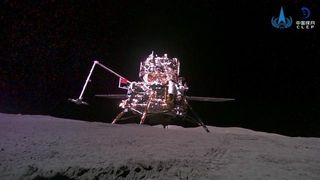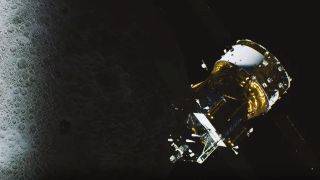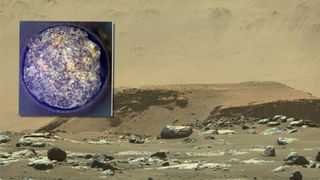Leonard David is an award-winning space journalist who has been reporting on space activities for more than 50 years. Currently writing as Space.com's Space Insider Columnist among his other projects, Leonard has authored numerous books on space exploration, Mars missions and more, with his latest being "Moon Rush: The New Space Race" published in 2019 by National Geographic. He also wrote "Mars: Our Future on the Red Planet" released in 2016 by National Geographic. Leonard has served as a correspondent for SpaceNews, Scientific American and Aerospace America for the AIAA. He has received many awards, including the first Ordway Award for Sustained Excellence in Spaceflight History in 2015 at the AAS Wernher von Braun Memorial Symposium. You can find out Leonard's latest project at his website and on Twitter.
Latest articles by Leonard David

'Drawn to our planet:' How spaceflight changed SpaceX Inspiration4 astronaut Chris Sembroski
By Leonard David published
Space.com caught up with Inspiration4 crewmember Chris Sembroski to discuss the landmark 2021 SpaceX mission and how it affected him.

SpaceX Starship landings could contaminate water ice on the moon
By Leonard David published
Could human landing systems touching down on the moon deliver water from their rocket exhaust plumes? New research says it's a possibility.

Get an up-close look at China's Chang'e 6 farside moon rover (video)
By Leonard David published
More information has come to light regarding the hitchhiking mini-rover on China's Chang'e 6 sample-return mission to the moon's far side.

Find a piece of SpaceX space junk? Call the hotline
By Leonard David published
SpaceX has established a debris hotline and a special email address to aid folks who may have found fallen pieces of the company's hardware.

Could we launch resources from the moon with electromagnetic railguns?
By Leonard David published
Electromagnetic launches of material from the lunar surface can be more efficient than conventional rocket launches that rely on chemical fuels sent from Earth. But are they feasible?

How SpaceShipOne's historic launch 20 years ago paved the way for a new space tourism era
By Leonard David published
On June 21, 2004, SpaceShipOne reached the final frontier for the first time, notching a huge milestone for private spaceflight and paving the way for space tourism.

NASA moon orbiter spots Chinese lander on lunar far side (photo)
By Leonard David published
NASA's Lunar Reconnaissance Orbiter has taken its first look at China's Chang'e 6 spacecraft on the moon's far side.

Chinese moon researchers gearing up for June 25 arrival of far side samples
By Leonard David published
Chang'e 6 will deliver unprecedented cargo to Earth.

China's Chang'e 6 mission carried a stone flag to the moon's far side
By Leonard David published
The Chinese flag that the Chang'e 6 mission brought to the moon's far side is made primarily of basalt, a volcanic rock that's plentiful on the lunar surface.

China's Chang'e 6 probe starts collecting 1st lunar far side samples to be brought to Earth
By Leonard David published
China's Chang'e-6 lunar mission has carried out a successful far side touchdown and is already busily gathering specimens for send-off to Earth.

1st annual space piracy conference will examine threats of orbital crime and smuggling
By Leonard David published
The First Annual Space Piracy Conference aims to explore the risks of piracy in space and solutions to this potentially devastating economic and legal problem.

China's Chang'e 6 probe to land on far side of the moon this weekend to return lunar samples to Earth
By Leonard David published
China's Chang'e 6 moon mission is studying landing sites on the lunar far side for accessibility ahead of a planned touchdown attempt this weekend.

Is it time to put a dimmer switch on the push for space solar power?
By Leonard David published
The thought of beaming power to an energy-hungry Earth from space has long been studied. It was first proposed over 80 years ago in science fiction.

China's Chang'e 6 mission gearing up for early June landing on moon's far side
By Leonard David published
China's robotic Chang'e 6 sample-return mission to the lunar far side is now in orbit around the moon, gearing up for its landing attempt.

Perseverance rover's Mars rock sample may contain best evidence of possible ancient life
By Leonard David published
These samples are uniquely important for return to Earth for further study.

NASA, ESA join forces on life-hunting ExoMars rover
By Leonard David published
NASA and ESA have signed an agreement to team up on the ExoMars rover mission, which aims to launch a life-hunting robot toward the Red Planet in 2028.

How NASA's Ingenuity helicopter opened the Mars skies to exploration
By Leonard David published
The Ingenuity Mars helicopter's flying days may be over, but its influence will be felt far into the future.

Blinded by the light: How bad are satellite megaconstellations for astronomy?
By Leonard David published
The emergence of satellite megaconstellations like SpaceX's Starlink offers great benefits for humanity. But there are also substantial costs, including a growing imposition on astronomy.

Handle Mars with care: Guidelines needed for responsible Red Planet exploration, experts say
By Leonard David published
A new study calls for "geoconservation" principles applied to space, so that astronauts exploring Mars and other cosmic bodies don't compromise future scientific work.

China to launch sample-return mission to the moon's far side on May 3
By Leonard David published
China reportedly plans to launch its Chang'e 6 sample-return mission toward the moon's mysterious far side on Friday (May 3).

Mars exploration, new rockets and more: Interview with ESA chief Josef Aschbacher
By Leonard David published
Space.com caught up with ESA Director General Josef Aschbacher recently to talk about Europe's space plans and priorities going forward.

Building rockets and looking for life on Venus: Q&A with Rocket Lab's Peter Beck
By Leonard David published
Space.com caught up with Rocket Lab founder and CEO Peter Beck recently to talk about the company's ambitious plans for the future, which include a private life-hunting mission to Venus.

'Astrobiodefense:' Thinktank calls for defending Earth from space bugs
By Leonard David published
"As fantastical as it may sound, astrobiodefense is neither hypothetical nor fictional."
Breaking space news, the latest updates on rocket launches, skywatching events and more!



